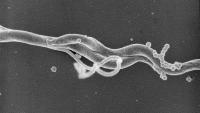Key Terms

Encephalopathy
Disturbance or disease of the brain. In Lyme disease, this term usually refers to the cognitive problems that can occur later in the course of Lyme disease.
Meningitis
Inflammation of the meninges surrounding the brain. Patients may experience headache, light sensitivity, pain when moving the head, nausea and vomiting. Patients with Lyme disease typically develop this as an early neurologic reaction to infection with the agent of Lyme disease.
Encephalitis
Inflammation of the brain. Patients may experience confusion, irritability, spontaneous tearfulness, geographic disorientation, sleep disturbance, and impaired memory, attention, and/or verbal fluency.
Encephalomyelitis
Inflammation of the brain and spinal cord. Patients may experience symptoms affecting the brain such as confusion, headache, word-finding problems as well as signs of spinal cord involvement such as weakness, sensory loss in the legs, urinary problems. The cerebrospinal fluid may show abnormalities such as increased white blood cells. Encephalomyelitis may be triggered or perpetuated by viral or other infections such as spirochetal infection with Borrelia burgdorferi. Lyme encephalomyelitis may be mistakenly diagnosed as multiple sclerosis.
Radiculopathy
A disturbance in the nerve that may cause shooting pain, numbness or tingling in the distribution of a nerve root. Emanates from the spinal cord. "Sciatica" is a good example of radicular pain in that it starts from the spinal cord and shoots down the leg.
Erythema Migrans
An expanding rash that is almost pathognomonic for Lyme disease, occurring shortly after the tick bite in many but not all patients. Satellite rashes may occur at later points in the illness. The best- known appearance is of a "bull's eye" — a red rash with central clearing that gradually enlarges. The "target" or "bull's eye" is however seen in only 20% of the Erythema Migrans (EM) cases. The most common appearance is a confluent red or pink rash with a distinct border that expands; when it expands to greater than two inches, the likelihood of this being a true EM rather than a local irritant reaction to the tick bite is greater. The EM rash may have a wide variety of other appearances as well.
Vasculitis
Inflammation of the blood vessels. Many diseases can cause a vasculitis, such as lupus, syphilis, cocaine abuse, Lyme disease, and primary angiitis of the central nervous system.
Herxheimer Reaction
This typically refers to an exacerbation of symptoms or new onset of symptoms shortly after starting antibiotic therapy. This is thought to be due to a flare of the immune system in response to the killing of the spirochetes. Because of this reaction, it is sometimes the case that a physician will tell the patient: "You feel worse? Terrific! That's a sign you're getting better."
Seronegativity
This refers to the situation in which blood tests for Lyme disease do not indicate past or current infection. Most patients may in fact test negative because they are being tested too soon after the tick bite; others may test negative because they have been treated with antibiotics that diminish the immune response.
PCR (Polymerase chain reaction)
This refers to one of the tests used to help detect the genetic material (DNA or RNA) of the spirochete that causes Lyme disease. Unlike the ELISA and Western blot which only tell you that a person's immune system has generated antibodies to the spirochete, the PCR actually tells you that pieces of the genetic material of the organism are present. This test is considered to be a stronger indication that the organism that causes Lyme disease is actually present in the body. However because the Lyme spirochete only stays in the blood for short periods after initial infection, PCR testing of the blood will often be negative even among patients who do have active infection.
Neuropsychological Testing
This is not the same as neuropsychiatric testing. Neuropsychiatric testing is not a precise term, but it usually refers to an interview conducted by a psychiatrist who asks about mood, medical status, and cognition (sometimes performing a small set of tests of memory and attention in the office). Neuropsychological testing refers to a formal battery of tests of brain functions, such as auditory and visual memory, auditory and visual attention, visual motor performance, intelligence, speed of mental processing, verbal fluency, mental flexibility. A comprehensive battery, usually performed by a neuropsychologist, may take three to eight hours or more.
Proteomics
Proteomics refers to the use of biotechnology to study the entire array of proteins produced by an organism or system. This varies according to the individual and hence is more complicated than genomics because an organism’s genome is relatively constant. Protein expression however varies depending on both the genes and environmental stressors. In the past, protein expression was studied by mRNA analysis, but because mRNA is not always translated into protein, proteomics has stepped in to confirm the presence and quantity of protein.
Genomics
Genomics refers to the study of an organism's entire genome. Typically the entire DNA sequence of an organism is mapped, with a particular interest in observing interactions between loci and alleles within the genome. This method is different from standard techniques in molecular biology which focus on identifying the functions of specific genes. More broadly speaking, some researchers consider genomics to refer to the study of all of the genes of a cell or tissue, at the level of the genotype (DNA), transcriptome (mRNA) or proteome (protein). While the genome of healthy cells is constant, certain environmental stressors, such as a viral infection, can add genetic material to the cell and alter its expression and function.
Xenodiagnosis
Xenodiagnosis in Lyme disease research refers to the confirmation of spirochetal infection by exposing an infected animal to an uninfected tick and then examining the previously uninfected tick (by PCR or culture) for the presence of the infective microorganism. Ticks are often more successful in sucking up spirochetes from the mouse then a scientist would be by drawing blood or random tissue biopsies.